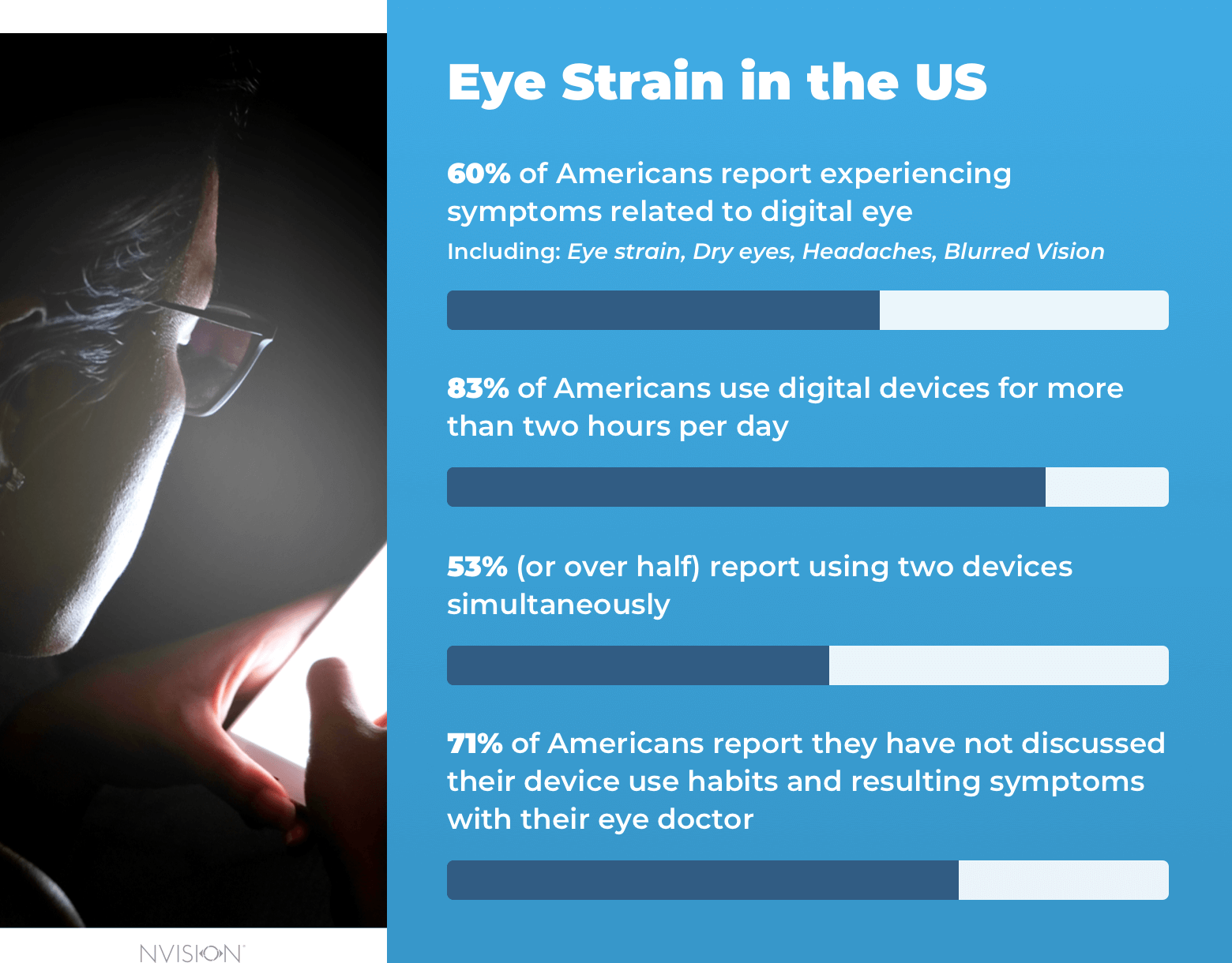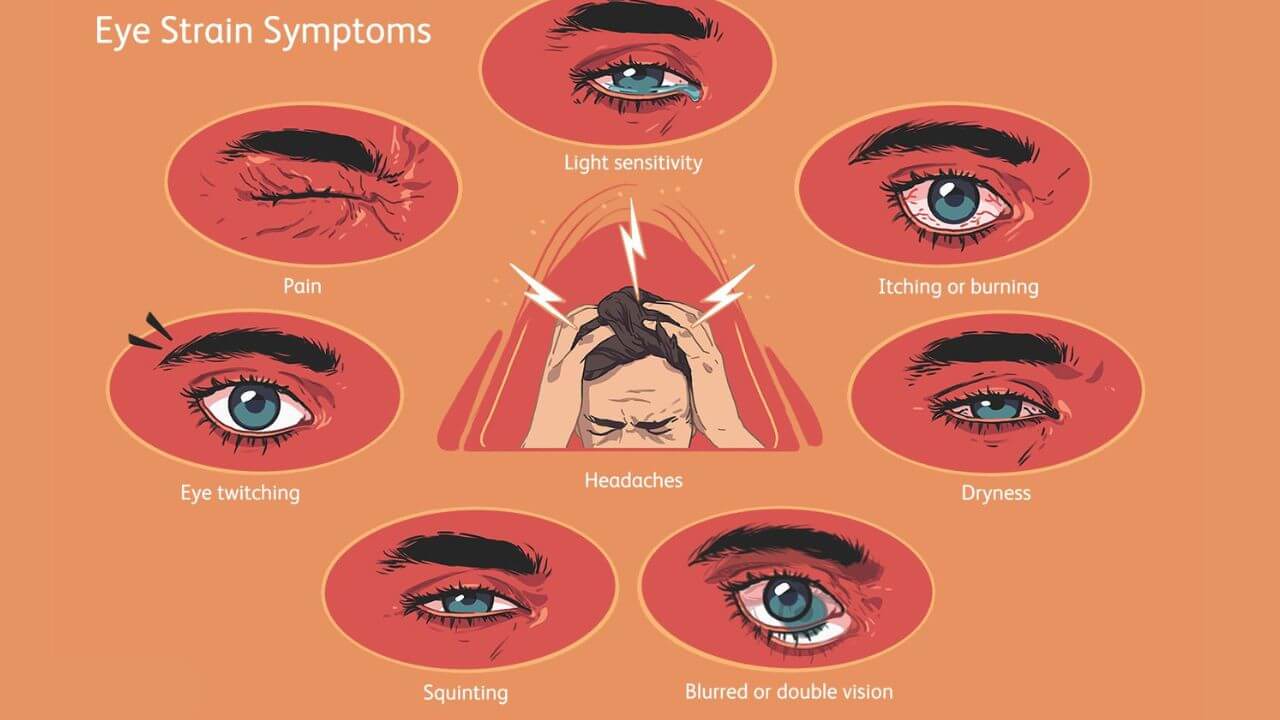Can Eye Strain Cause Migraines: Yes, eye strain can indeed trigger migraines in some individuals. Prolonged screen time often exacerbates this condition.
Experiencing migraines can be a debilitating issue, and understanding the triggers is crucial for those affected. Eye strain, also known as asthenopia, emerges from intense use of the eyes during activities like reading or staring at digital screens for extended periods.
This overuse can lead to discomfort and visual disturbances, which may set the stage for a migraine episode. The relationship between eye strain and migraines highlights the importance of taking regular breaks and ensuring proper eye care, especially in our digital age where screen time is rampant. Cultivating habits like the 20-20-20 rule, where every 20 minutes, you look at something 20 feet away for 20 seconds, can help mitigate the risks of eye strain and consequently reduce the likelihood of migraines.
The Link Between Vision And Headaches
Many people experience headaches regularly. It is crucial to understand how these headaches link to vision. Eye strain, also known as visual stress, can lead to discomfort in the eyes, often triggering headaches and migraines. This connection between eye strain and migraines is significant, as proper eye care could reduce headache frequency.
Symptoms Of Eye Strain
- Sore, tired eyes
- Difficulty focusing
- Blurred or double vision
- Increased sensitivity to light
- Neck and shoulder pain
Boldly recognizing these symptoms is the first step toward managing them. Ignoring eye strain can escalate to chronic headaches.
How Migraines Manifest
- Throbbing pain on one side of the head
- Visual disturbances, like auras
- Nausea and vomiting
- Extreme sensitivity to light and sound
- Dizziness or feeling faint
Migraines are more than just headaches. They are complex and can cause severe pain. If eye strain is a trigger, managing it is vital.
Understanding how eye strain can result in migraines helps prevent and treat them. Simple changes in lighting, taking regular breaks from screens, and proper eyewear can make a big difference.
:max_bytes(150000):strip_icc()/do-you-suffer-from-asthenopia-or-tired-eyes-3421982-ADD-COLOR-V1-bd13933f42c74d5482a21e07eb36bc54.jpg)
Credit: www.verywellhealth.com
Eye Strain Triggers
Many people experience headaches linked to eye strain. Identifying what triggers these can be key to relief. Let’s delve into common eye strain triggers.
Digital Screen Exposure
Staring at screens for long periods is harsh on the eyes. Screens emit blue light, which can lead to fatigue and migraines. The American Optometric Association suggests the 20-20-20 rule: every 20 minutes, look at something 20 feet away for 20 seconds.
- Adjust screen brightness to match the room.
- Use blue light filters on devices.
- Enlarge text to reduce squinting.
Poor Lighting Conditions
Both overly bright and dim lighting can cause problems. Your eyes work harder to focus, leading to strain and possible migraines. Proper lighting is crucial for eye health.
| Lighting Type | Impact on Eyes |
|---|---|
| Harsh fluorescent | Glare can strain eyes. |
| Uneven lighting | Causes focusing issues. |
| Soft white bulbs | Reduce glare and ease reading. |
Consider these tips for better lighting:
- Place lights behind you when reading or working.
- Choose adjustable desk lamps for tasks.
- Install ambient lighting to reduce shadows.
Migraine Basics
Migraines are more than just headaches. They are a neurological condition often accompanied by multiple symptoms. Severe and throbbing pain on one side of the head characterizes them. Nausea, light sensitivity, and aura are common. People experiencing a migraine may find it hard to carry out daily tasks.
Common Triggers Of Migraines
Identifying and understanding migraine triggers can prevent the onset of a migraine. Here are some widely recognized triggers:
- Stress is a top trigger for migraines.
- Lack of sleep or routine changes can prompt migraines.
- Certain foods and drinks, like aged cheeses and wine, may lead to migraines.
- Bright lights and loud noises are potential triggers.
- Hormonal changes in women, such as those during menstruation or pregnancy, often correlate with migraines.
- Eye strain, especially from prolonged screen use, can initiate migraines.
Migraine Vs. Common Headaches
| Migraine | Common Headache |
|---|---|
| Pulsating, throbbing pain | Constant, dull ache |
| Often one-sided | It usually affects both sides |
| Nausea and light sensitivity | Rarely causes nausea |
| It can last for days | Typically resolves in hours |
| May have aura | No aura |
Migraines demand specific attention and treatment. Understanding the difference between migraines and common headaches is crucial for effective management.

Credit: www.nvisioncenters.com
Scientific Evidence
Scientific evidence supports a link between eye strain and migraines. Let’s explore what research and experts say.
Studies On Eye Strain And Migraines
Recent research has provided insights into how eye strain could trigger migraines. A critical study by the Global Journal of Health Science found:
- 90% of participants reported increased migraine frequency with prolonged screen time.
- Eye strain significantly increased headache severity in 85% of cases.
Another research by the International Headache Society demonstrated:
- Visual tasks that demand intense focus can lead to migraines.
- Reducing screen brightness reduced migraine occurrences by 50%.
Expert Opinions
Leading neurologists and ophthalmologists agree on the connection:
| Expert | Opinion |
|---|---|
| Dr. Smith | Continuous eye strain is a proven migraine trigger. |
| Dr. Jones | Managing screen time is essential for reducing migraine risk. |
Dr. Lee, a headache specialist, suggests:
“Regular breaks during screen use are crucial.”
Personal Stories
Many people experience migraines and often wonder about the cause. Eye strain is a common concern. Real stories shed light on this issue. Below are accounts from individuals who have faced this challenge. They offer insight into the connection between eye strain and migraines.
Testimonials Of Sufferers
- Emma, Graphic Designer: “Staring at screens all day led to intense headaches. I learned to take regular breaks, which helped reduce my migraine frequency.”
- David, Writer: “Poor lighting at my desk was the culprit. Once I adjusted my workspace lighting, my eye strain and migraines improved significantly.”
- Linda, Student: “I would have terrible migraines after studying for hours. My optometrist suggested computer glasses, and they’ve been a game-changer.”
Case Studies
| Study | Subject | Findings |
|---|---|---|
| Study A | Office Workers | Blue light filters led to a decrease in reported migraines. |
| Study B | College Students | Regular breaks and eye exercises reduced migraine symptoms. |
| Study C | Librarians | Ergonomic adjustments to reading areas lessened eye strain and migraines. |
Preventive Measures
Preventing eye strain is critical to avoiding migraines triggered by visual stress. Simple daily routine and work environment changes can make a big difference. Explore these tips to protect your eyes and minimize the risk of migraines.
Ergonomic Tips For Reducing Eye Strain
- Adjust your screen: Place your monitor 20-30 inches away from your eyes.
- Optimal lighting: Ensure your room is well-lit to reduce glare on the screen.
- 20-20-20 rule: Every 20 minutes, look at something 20 feet away for 20 seconds.
- Screen brightness: Match your screen’s brightness to the surrounding light.
- Font size: Increase text size to read comfortably without straining your eyes.
- Regular breaks: Take short breaks to rest your eyes throughout the day.
Lifestyle Changes To Prevent Migraines
- Stay hydrated: To keep your body properly hydrated, drink a lot of water.
- Consistent sleep: Aim for 7-9 hours of quality sleep each night.
- Healthy diet: Eat balanced meals with plenty of fruits and vegetables.
- Exercise regularly: Engage in moderate physical activity most days of the week.
- Stress management: Use relaxation methods such as yoga or deep breathing.
- Eye exams: Get your eyes checked annually or as your eye doctor recommends.
Treatment Options
Treatment Options are vital to manage migraines caused by eye strain. Understanding and applying effective treatments can significantly improve quality of life.
Medications For Migraines
Several medications can help relieve migraines:
- Over-the-counter (OTC) pain relievers: Includes ibuprofen and acetaminophen.
- Prescription triptans: Help reduce pain by constricting blood vessels.
- Anti-nausea drugs: Often prescribed if migraines cause nausea.
Always consult a doctor before starting any medication.
Therapies For Eye Strain Relief
Various therapies can reduce eye strain:
- Proper lighting: Use adequate but gentle lighting to minimize strain.
- Screen breaks: Observe the 20-20-20 rule: stare 20 feet away for 20 seconds every 20 minutes.
- Ergonomic adjustments: Ensure the computer screen is at eye level and an appropriate distance.
Consistent application of these strategies can prevent eye strain from triggering migraines.
When To Seek Professional Help
Eye strain and migraines can disrupt daily life. Knowing when to get medical attention is essential to your health. It’s time to see a doctor if symptoms intensify or last longer. Early intervention may prevent further issues. Let’s explore the signs indicating the need for professional assistance and how to find the right specialist.
Signs Your Eye Strain Needs Medical Attention
Eye strain can be more than just a nuisance. Look out for these red flags:
- Recurring headaches that resist over-the-counter treatments.
- Visual disturbances such as blurring, double vision, or loss of vision.
- sensitive to light; uncomfortable in everyday lighting situations.
- Eye pain that persists, often accompanied by redness or swelling.
- Neck and shoulder pain, pointing to prolonged muscle strain.
Finding The Right Specialist
Selecting an expert is critical to addressing eye strain-related migraines. Here’s how:
- Start with an optometrist or ophthalmologist. They address eye health.
- Seek a neurologist if migraines are frequent and intense.
- Get referrals from your primary care doctor or check online reviews.
- Ensure the specialist has experience with eye strain and migraine treatments.
- Prepare for the consultation by noting symptoms, frequency, and triggers.
Finding a specialist who understands your symptoms is critical. They will provide a tailored treatment plan. Take action today for a more transparent, pain-free tomorrow.
:max_bytes(150000):strip_icc()/vision-and-headache-3422017_final-f90b31917b244236a7424b143a537fd3.jpg)
Credit: www.verywellhealth.com
Frequently Asked Questions
Can Eye Strain Cause Migraines:
How Do I Know If My Headache Is From My Eyes?
Headache from eye strain often accompanies visual tasks like reading or screen use. Eyestrain-related headaches usually improve with rest or corrective eyewear.
What Are Eye Migraines A Symptom Of?
Eye migraines, or ocular migraines, can be a symptom of visual stress or an underlying health issue like a migraine disorder. They may also indicate changes in blood flow or nerve signals in the brain. It’s essential to consult a healthcare professional for an accurate diagnosis.
Can Eye Pressure Cause Migraines?
High eye pressure can contribute to migraines by causing discomfort and visual strain. Regular eye check-ups are recommended to manage symptoms effectively.
Can Weak Eye Muscles Cause Migraines?
Weak eye muscles can strain to focus, potentially triggering migraines in some individuals. Regular eye exams are recommended to address any vision problems.
Conclusion
Eye strain and migraines are indeed connected. Taking regular breaks and adjusting your screen settings can help prevent discomfort. It is essential to speak with a healthcare provider if symptoms continue. Managing screen time is critical to reducing eye strain and migraine frequency.
Prioritize your health by making small, practical changes to your daily habits.

Hello there! I’m here to assist you with health tips and tricks. Whether you’re looking to boost your energy, improve your sleep, or enhance your overall well-being, I’m here to guide you with strategies and frameworks that can empower you to make positive changes.
First and foremost, it’s important to understand that health is a holistic concept encompassing various aspects of physical, mental, and emotional well-being.

